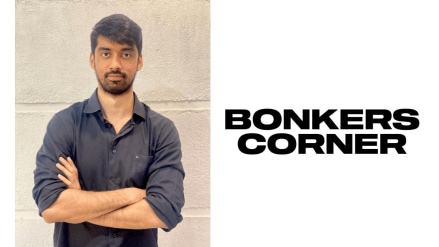“Fashions fade, style is eternal,” said Yves Saint Laurent and Laurent couldn’t have been more right with how fashion trends may evolve but comfort remains top tier. The pandemic triggered a shift in the streetwear market, with Gen-Z driving demand for loose, relaxed fit over traditional tailored styles. Brands quickly capitalised on this trend, adjusting product lines and inventory to meet the surge in popularity of baggy, oversized clothing. This style seems to have become a staple across wardrobes for students, young professionals, and active consumers, marking a profitable chapter for companies that adapted early to the comfort-focused shift in fashion. Bonkers Corner, which began as an Internet-first brand, claims to have initiated the shift toward oversized clothing with its tees, joggers, track pants, and sweatshirts. Recently, the brand opened its 11th store in Surat, marking its expansion into the retail space.
The company’s revenue from operations rose 2.05 times to Rs 65.31 crore in FY23 from Rs 31.86 crore in FY22. It posted a net profit of Rs 4.65 crore in FY23 from a net loss of Rs 50.24 lakh in FY22, according to regulatory filings accessed by business intelligence platform Tofler.
In a conversation with BrandWagon Online, Shubham Gupta, founder and CEO, Bonkers Corner, talks about how its company made a space in the streetwear market, its expansion strategy, global tie-ups, and plans for FY25, among others. (Edited Excerpts)
How did FY24 perform in terms of revenue and profit for your company, and what are your expectations for FY25?
In FY24, we achieved a total revenue of Rs 100 crore with a net profit margin of approximately nine per cent. We plan to expand into the denim category, targeting the 25-35 age group. Additionally, we will also focus on shirts, jackets, and dresses, among others.
For all our products, we use Japanese technology exclusively, avoiding any Chinese components. Moving forward, our goal is to make our products even more premium.
Can you tell us about your journey as a brand and a startup, and how you navigate competition in the streetwear market, given the presence of other D2C and established brands?
We launched in 2020 during the lockdown. I had been white-labeling for various e-commerce brands, and that experience inspired me to start something of my own. In the early days, we focused on mass sales, and we were the first brand to popularise the oversized clothing trend in India on a large scale. Initially, no other brand focused on oversized clothing for the mass market, but soon, others followed suit.
In 2020, we started with just 10 orders a week, and by the end of that year, we were processing 3,000 orders weekly. Today, we dispatch around 6,000-7,000 orders daily.
What were your most significant challenges in establishing and scaling your brand?
The challenges we faced before were different from those we face now. Initially, the focus was deciding what products to create and establishing our brand identity. Today, the challenges involve building and expanding the team and implementing automation within our systems. We started with a team of just 10 people, and now we have over 1,000 employees.
As you transition from an Internet-first brand to expanding in offline retail, which channel has proven most effective for your growth? How do the dynamics differ between online and offline spaces, and which one holds greater strategic importance for your brand’s future?
When we opened our first store, we noticed a strong conversion rate. For instance, on the back of a footfall of 100 people, our conversion rate was 70%. This success encouraged us to focus more on retail, as customers can now experience and try our products firsthand, and we’ve received positive feedback on both quality and price points. We plan to continue expanding our retail presence.
In addition to making a quality product, having a strong marketing strategy is equally important. What is your overall marketing strategy, and which marketing channels do you prioritise?
Digital is important for us but currently, we’re not investing heavily in Meta or Google. While we have a budget allocated, we’ve chosen to reduce spending there. Our strategy from day one has been to address market gaps—for example, identifying products that are either unavailable or priced at a premium by major brands. Our goal is to offer affordable luxury in this segment.
We previously leveraged influencer marketing, but with the increasingly cluttered environment and unnecessarily high fees, we’ve reduced our investment in this area as there is very little ROI.
What are the company’s expansion plans?
We aim to expand across India and have recently secured two exclusive global licenses that no other brand currently holds in the country due to eligibility requirements with Smiley Originals. For example our previous collaborations include Hello Kitty. These upcoming licenses are unique to our brand in India.
Which regions or customer segments contribute the most to your sales and what is your distribution strategy?
Our target audience is Gen-Z, who seek trendy, fashionable apparel on a budget. Gen-Zs contribute most. In terms of region, Maharashtra contributes almost 30% of our sales and the rest are other metro cities like Delhi, Bengaluru, and Hyderabad, among others.
We are also available across all e-commerce platforms including our own D2C website.
Given the rise of D2C brands and increased competition in the market, what is your pricing strategy, and how do you maintain a balance between offering quality products and ensuring affordability?
Our pricing strategy ensures that each product’s manufacturing cost is about half of its retail price. For example, if a product sells for Rs 800, we aim to manufacture it for around Rs 400. All of our products are produced in-house, without any outsourcing. Additionally, we have remained entirely bootstrapped up to this point and not planning for any investment as of now.
